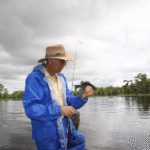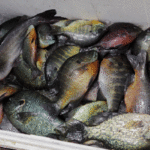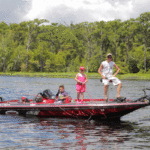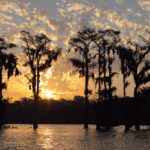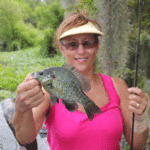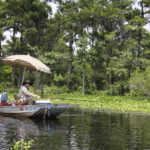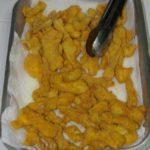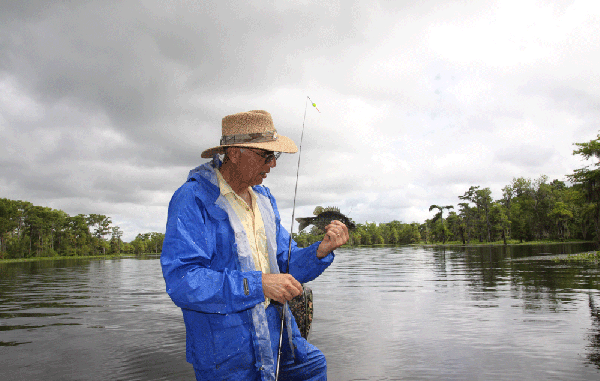
This Basin hotspot has an abundance of eager bream that are fat and happy this time of year.
The anchor hadn’t settled on the bottom good before my wife made her first cast toward the trees along a stretch of Bear Bayou we regularly fish. As normal, she wasn’t playing around. And before I even had a worm on my hook, she was setting hers into the lips of a chinquapin.
The bluish-green colored fish streaked just beneath the surface, touching off my adrenaline button that caused me to get a little more worm juice on my fingers than I had planned.
“Dang Christine — that was quick,” I said, while watching her haul in the little scrapper doing its best to put up a fight.
“But I think it’s too small,” I continued, sounding like a party pooper.
“Uh-ahh,” she replied incredulously.
“I’m telling you it’s too small — gotta be 7½ inches minimum or it doesn’t go in the ice chest,” I said firmly, not wanting to clean something that would provide little more than a potato chip size piece of fried fish.
“Well, get your tape measure out — it’s big enough,” she said, winning the test of wills before the first rays of sunshine rose above the cypress trees in the Atchafalaya Basin.
Eating a little crow after breaking out my little tape measure, I had to admit the fish did indeed make the cut.
The truth be known, I should have never doubted the size. The quantity of quality-size bream we would catch that morning or any morning throughout the summer in this part of the basin is arguably as good as it gets anywhere in the state.
What makes Bear Bayou so good for bream is the thick grass that runs parallel with the bank extending out into the deep water. The combination of thick grass and firm bottom is highly suitable for spawning bream. What’s more, since bream spawn up to three times throughout the summer, Bear Bayou is a haven for these fish.
Bear Bayou has long been a preferred location for local bass anglers and crawfishermen. Two of the most common sights throughout the spring well into June are bass boats and Pro-Drive-powered skiffs that get up into the trees when the water is over the bank.
All of the local competitive bass anglers who frequent the area know where the structure is along Bear Bayou. Invariably, by watching where they cast and nail a bass or two will tip you off to potential locations where bream also hang out around the fallen trees, submerged logs and stumps they fish.
The commercial and recreational crawfishermen cut rows and holes in the thick sub-aquatic vegetation with their props in determined attempts to fill their sacks with the freshwater crustaceans. Hook and line can be dropped into these open spots, where bream tend to congregate feeding on anything edible that drains out of the backwater swamps.
Normally clear, the water in Bear Bayou is conducive to letting you see a lot of the action that takes place, as fish dart off with your bait suspended under a bobber — the preferred method for fishing chinquapins.
However, Morgan City resident Chris Black, who frequently fishes the area for bream, uses a couple different tactics that tend to produce a few bigger fish.
One such method is trolling.
“I think we catch a lot more and a lot bigger fish trolling instead of sitting in one spot,” said Black, who mentioned he learned to fish that way from his father. “A lot of people like to tie up in one area and kind of fish it. They catch the big ones upfront and then start catching the smaller ones. They school up like that and they live together. I just find you catch bigger fish if you move around and fish tree to tree.”
Black also fishes without a bobber much of the time while he trolls the grass beds along the edges of Bear Bayou.
“Most of the time I do not use a float when I fish for bream in Bear Bayou,” he said. “When I fish up in the trees, I’ll put a float on and try to check different depths to find out where they are. But when I’m trolling I’ll work a jig with a little piece of worm. My son actually took his float off one day, and we backed off the trees a little ways and started fishing in the grass in about 6, 7 or 8 feet of water. He started catching, so I took mine off, and we’ve been doing it that way ever since.”
Black’s two youngest children accompany him often to Bear Bayou. My wife and I met Talen and Olivia Black last summer fishing with their dad.
“What I like most about fishing Bear Bayou is that I grew up fishing the area with my father,” said Black. “I was little when he took me in there, and I’ve been taking all of my kids there since they were little. Plus, it’s also close to home.”
As everyone knows, when the bream bite starts, it doesn’t take anything fancy to entice them. Worms, crickets and small shiners work best when talking live bait. Hair jigs, tube jigs and 1/16-ounce Johnson Beetle Spins are the standard artificial baits known for taking bream.
However, bream will feed at all levels in the water column. As water in the basin drops the further into summer it gets, it’s quite common to see bass anglers working topwater baits such as frogs, buzz baits and Heddon Torpedoes and rattling Spooks as the first rays of morning sun provide a yellow haze on the cypress-dotted horizon.
Bream will feed on the surface as well — smacking insects and smaller minnow-size baitfish. Floating baits like the new Berkley floating mouse tail or fly fishing balsa popping bugs are good artificial baits to use that will entice larger red-eared sunfish and bluegills to the surface.
Large bream aren’t very big when compared to the “large” versions of other game fish, such as bass, sac-a-lait and even goggleyes they share most bayous with — it’s a relative thing. Moreover, bream are also lower on the food chain and are known to be “big fish food” too. But, a 7½-inch chinquapin caught on ultra-light tackle can be as much fun as fighting any of the other larger fish.
My personal bream-fishing rig consists of an 11-foot-long Wally Marshall crappie pole, 6-pound-test line, and Abu Garcia Cardinal 100i ultra-light reel. I’ve landed scores of bream with this combination leaving the basin with not just an ice chest full of tasty fillets, but satisfied with a morning full of action.
By June it’s important to take notice of the weather conditions when bream fishing in the basin. First and foremost, it’s extremely hot by mid-morning. And, second, the normal summer pattern includes periodic rainsqualls that can catch you off guard.
Having caught our share of basin bream, my wife and I ran into Morgan City resident Troy Theriot fishing the mouth of Bear Bayou, where it opens into Flat Lake. We slowed to watch the fisherman land a few bream and admire his umbrella.
Theriot, unlike us, fished under the umbrella to beat the heat. He was also covered to his wrists in a long-sleeved shirt protecting his skin from exposure to the sun’s rays. With a long pole, bullet float and some small worms, he also was putting his share of bream in the ice chest.
Bream action remains hot in the Bear Bayou region of the Atchafalaya Basin well into late September and, often, early October before they scatter. There’s no shortage of chiquapins and bluegills, but if you’re into a self-imposed length like I am, be sure to carry a little tape measure marked at the 7½-inch spot. It’s bound to save you a few arguments.
How to get there
Bear Bayou begins at the extreme north end of Flat Lake. Take Highway 70 from either Highway 90 or I-10, and head to Morgan City. Follow 70 to Lake End Park, where across the road you’ll see the sign for Russo’s Landing.
